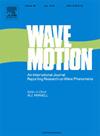On peridynamic acoustics
IF 2.1
3区 物理与天体物理
Q2 ACOUSTICS
引用次数: 0
Abstract
We consider a nonlocal (peridynamic) version of the classical forced wave equation. This scalar three-dimensional equation contains a weight function (the “micromodulus”) and a length parameter (the “horizon”) that have to be selected. We investigate various properties (the locality limit as the horizon shrinks, plane waves and group velocity), paying attention to how these properties depend on the choice of the micromodulus. We solve the forced peridynamic equation in the static case (avoiding divergent integrals) and in the time-harmonic case (with a radiation condition, when needed).
关于周动声学
我们考虑的是经典强迫波方程的非局部(周动)版本。这个标量三维方程包含一个必须选择的权重函数("微模量")和一个长度参数("地平线")。我们研究了各种特性(地平线收缩时的位置极限、平面波和群速度),并关注了这些特性如何取决于微模量的选择。我们在静态情况下(避免发散积分)和在时谐情况下(必要时使用辐射条件)求解了受迫周流方程。
本文章由计算机程序翻译,如有差异,请以英文原文为准。
求助全文
约1分钟内获得全文
求助全文
来源期刊

Wave Motion
物理-力学
CiteScore
4.10
自引率
8.30%
发文量
118
审稿时长
3 months
期刊介绍:
Wave Motion is devoted to the cross fertilization of ideas, and to stimulating interaction between workers in various research areas in which wave propagation phenomena play a dominant role. The description and analysis of wave propagation phenomena provides a unifying thread connecting diverse areas of engineering and the physical sciences such as acoustics, optics, geophysics, seismology, electromagnetic theory, solid and fluid mechanics.
The journal publishes papers on analytical, numerical and experimental methods. Papers that address fundamentally new topics in wave phenomena or develop wave propagation methods for solving direct and inverse problems are of interest to the journal.
 求助内容:
求助内容: 应助结果提醒方式:
应助结果提醒方式:


